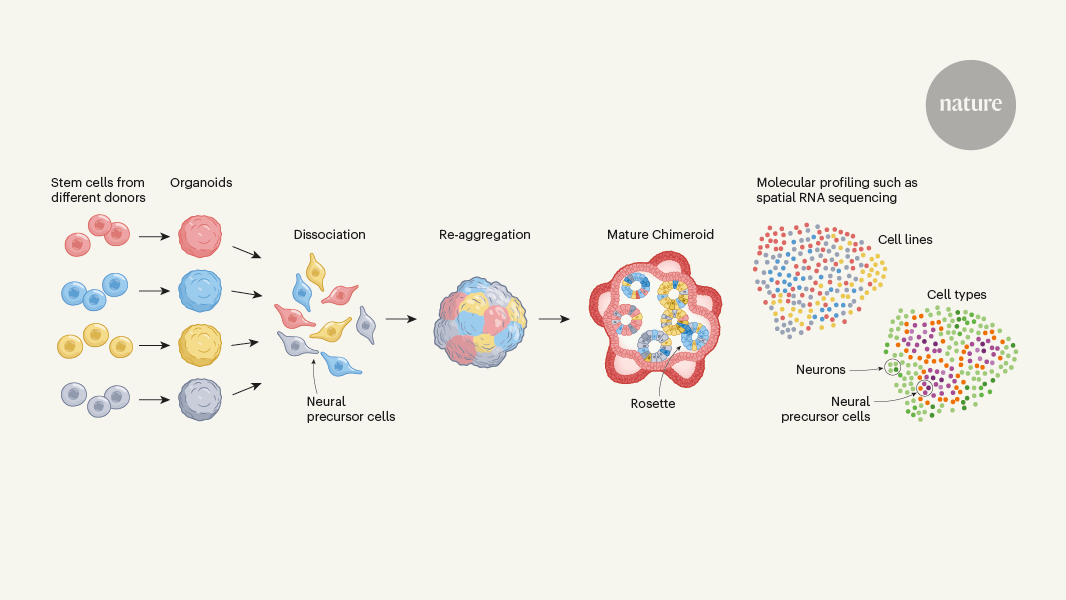Genetically Diverse Brain Organoids: Capturing Human Genetic Variation in 3D Cell Models
Core Concepts
Genetically diverse brain organoids, called "Chimeroids", can be created by mixing cells from different human donors to better represent the genetic variation found in human populations.
Abstract
The article discusses the challenge and desire to represent genetic diversity in 3D cell-based models of tissues, known as organoids, in the field of developmental neuroscience. The authors, Antón-Bolaños et al., describe an approach that relies on mixing cells from different human donors to create organoids that are genetic chimeras, dubbed "Chimeroids". This allows for the capture of human genetic diversity in these 3D cell models, which is an important step towards more accurately modeling human brain development and function.
Chimeric brain organoids capture human genetic diversity
Stats
No key metrics or figures were provided in the given content.
Quotes
No striking quotes were provided in the given content.
Key Insights Distilled From
by Aparna Bhadu... at www.nature.com 06-26-2024
https://www.nature.com/articles/d41586-024-01648-7
Deeper Inquiries
How can the "Chimeroids" approach be further refined and scaled to create more representative and diverse brain organoid models?
The "Chimeroids" approach can be refined and scaled by incorporating a larger pool of human donors to increase genetic diversity within the brain organoids. By carefully selecting donors with diverse genetic backgrounds, researchers can ensure a broader representation of human genetic variation in the organoids. Additionally, optimizing the ratios of different cell types from each donor in the chimeric organoids can help mimic the complexity of the human brain more accurately. Furthermore, refining the culture conditions and protocols to support the growth and development of these chimeric organoids over extended periods can enhance their representativeness and diversity.
What are the potential limitations or challenges in interpreting and analyzing data from genetically diverse brain organoids compared to more homogeneous models?
One potential limitation of interpreting data from genetically diverse brain organoids is the increased complexity in analyzing the interactions and effects of multiple genetic backgrounds within the same model. Understanding the specific contributions of each genetic component to the observed phenotypes can be challenging and may require advanced computational tools and analytical techniques. Moreover, variability in the responses of different genetic combinations within the chimeric organoids can introduce noise and make it harder to identify consistent patterns or outcomes. Additionally, the interpretation of results from genetically diverse organoids may require larger sample sizes to account for the variability introduced by genetic diversity, which can increase the cost and time required for experiments.
How might the insights gained from genetically diverse brain organoids inform our understanding of the role of genetic variation in human brain development, function, and susceptibility to neurological disorders?
Insights gained from genetically diverse brain organoids can provide valuable information on how genetic variation influences various aspects of human brain development, function, and susceptibility to neurological disorders. By studying the effects of different genetic backgrounds on the formation of neural structures, synaptic connections, and neuronal activity in chimeric organoids, researchers can uncover the specific genetic factors that contribute to these processes. Comparing the responses of genetically diverse organoids to external stimuli or drug treatments can also reveal how genetic variation influences the susceptibility to certain neurological disorders or the efficacy of therapeutic interventions. Overall, these insights can help elucidate the complex interplay between genetic diversity and brain function, offering new opportunities for personalized medicine and targeted treatments for neurological conditions.
0
